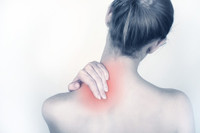 14th Aug 2015
14th Aug 2015
Pain Management Options for Chronic Pain
We recently had a patient come to the office for pain management who was diagnosed with Fibromyalgia over three years ago. She came in because she was in the beginning of a pain flare-up and had just started a new job. She was afraid to take sick time yet, but going on bed-rest was her go-to when dealing with a pain flare.

Currently over 100 million American suffers from chronic pain. There are many treatment options available to chronic pain sufferers, physical therapy among them, which can have a positive impact in their pain management. Our patient was pleased when her pain flare was cut short after two sessions and didn’t require her to miss work; on the contrary, she was able to keep up with her daily activities.
Physical Therapy Treatments for Chronic Pain
- Manual therapy: Manual therapy consists of specific, hands-on techniques that may be used to manipulate or mobilize your skin, bones, and soft tissues. Manual therapy is often used with other activities to increase movement and reduce pain.
- Movement and strengthening exercises: Moving and exercising can often be a great strategy to lessen pain. Your physical therapist will help identify specific movements that will help reduce your symptoms.
- TENS Unit: TENS stands for (Transcutaneous Electrical Nerve Stimulation) and this device is predominately used for nerve related pain conditions (acute and chronic conditions). TENS machines works by sending stimulating pulses across the surface of the skin and along the nerve strands. The stimulating pulses help prevent pain signals from reaching the brain. TENS devices also help stimulate your body to produce higher levels of its own natural painkillers, called "Endorphins".
- EMS: EMS stands for (Electrical Muscle Stimulation) and is predominately used to prevent, or reduce, muscle atrophy. EMS also helps by increasing blood flow to muscles, increasing range of motion, increasing muscle strength, as well as enhancing muscle endurance. However, EMS has pain management attributes in helping muscle related pain, such as a spastic muscle, sore muscles, or tight muscles.
- Cryotherapy: Using a cooler and cuff system, cryotherapy can provide patients with compression to relieve swelling and cold therapy to alleviate pain. The reduction in temperature with cryotherapy causes a positive chain of events; first, the cells' metabolic rate rapidly slows causing them to use less oxygen, as the local blood vessels constrict, this aids in slowing the flow of fluids to the injury site and swelling and pain is reduced.
The costs of unrelieved pain are high and can result in longer hospital stays, increased rates of re-hospitalization, increased outpatient visits, and decreased ability to function fully. As such, patient's unrelieved chronic pain problems can result in an inability to work and maintain health insurance. According to a recent Institute of Medicine Report: Relieving Pain in America: A Blueprint for Transforming Prevention, Care, Education, and Research, pain is a significant public health problem that costs society at least $560-$635 billion annually, including $297-$336 billion due to lost productivity (based on days of work missed, hours of work lost, and lower wages).
Chronic pain sufferers in the middle of a pain flare may be tempted to resort to inactivity or even bed-rest until the worst is over. It’s important to educate patients that they have pain management options outside of their prescription medication. Once they’ve experienced the relief first hand they will feel empowered to be pro-active in their pain management.
For more physical therapy advice and recommended treatment modalities please visit ProHealthcareProducts.com.





